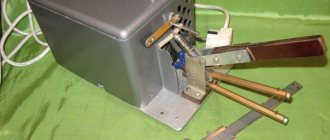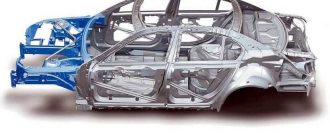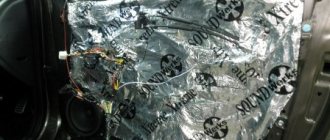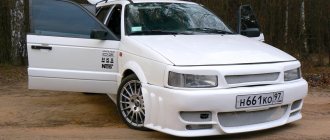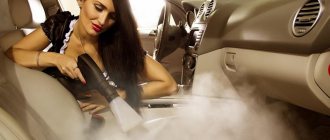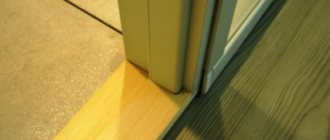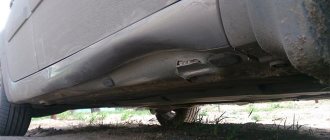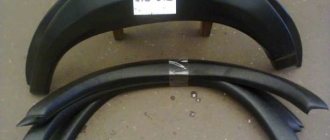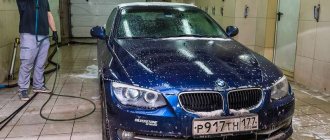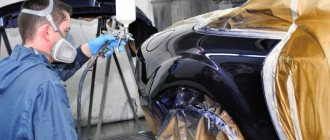How to diagnose the body and determine damage?
Today you can find hundreds of proposals from experts for body inspection and diagnostics. Such specialists help you make decisions when buying a car. You can also inspect the body yourself; to do this, it is enough to understand the stages of corrosion development. It is usually worth looking for the beginnings of rust on the wheel arches in the places where the fender liners are installed, as well as on the sills in their lower part. Door corners and bottoms often rust if left untreated. There are several stages of rust appearance:
- a process invisible to the eye begins under the paint in microcracks and various leaky places, it can only be seen under special devices, but this is not critical damage;
- then the paint swells in these places, and this is a really serious sign of the development of rust, this is not yet through corrosion, but you already need to work closely with the body to avoid problems;
- peeling of paint at the site of rust, growth of a stain that gradually exposes the metal and continues to enlarge the site of damage, undermining nearby layers of paint and varnish material;
- through corrosion is an irreversible stage at which it is already necessary to carry out complex welding work; simple processing will not work, starting from this stage;
- destruction of a body part - if repairs are not carried out at this stage, then the car can soon be sold for scrap; if the body is completely destroyed, the vehicle is worth nothing.
Welding work is actually required only at the fourth stage, when through corrosion appears. Before this, you can get by with cleaning the damaged area, treating it with special primers, painting and careful operation in the future. Once through holes appear in the metal, no treatment will help. You will have to carry out welding work and expose the body to additional troubles. Also, the price tag for such work is often very high.
Communities › Body Repair › Blog › Sos Help, how to treat the bottom after welding?
Comments 48
You take a coral circle on a grinder, clean everything down to bare metal, then degrease it, go over it with an abrasive material (120+ grit) and epoxy primer (necessarily 2-component), you can paint it on top and it will be fine.
And it seems to me that this is all bullshit. You can’t treat the surface properly, anyway. You only need to spray with soil once the rust has been completely eradicated. My suggestion is to apply zinc or orophosphoric acid, rinse, dry and coat with some oil-based anti-corrosion agent. For example, pushsalom. You can put cling film on top to prevent any smell.
I'm dealing with the same issue now. I took zinc primer, coated it with epoxy primer, then applied joint sealant under the brush (I covered the bottom panel on the boxes completely with sealant) and covered the whole thing with a rubber-bitumen mixture.
Roast stop mixed with lard or Movil. 50 to 50
I do this with an acid paint brush, then acrylic, epoxy, any paint, brushed with a thick layer... The seams are done with joint compound, but first clean them with a brush to remove scale and carbon deposits
"Hammerite" with a brush in a thick layer. Simple, fast and very reliable!
I would clean up the seam, if the car is being made for a good person :) or my own, then I would invest in epoxy, clean up the seam, blow epoxy, then body sealant, and then either anti-gravel, they say sealant based on MS-polymer is also quite good, I haven’t tried it myself still, but the coating is similar to raptor. In 2012 I made my own car, I remember that I used a thin layer of body acidifier, then primer-filler-base-varnish, bottom: body acidifier-3M sealant-body anti-gravel. I periodically tinted this sandwich and treated it 2 times with kindling, and blew it under the locker with a pushsal before the winter and that’s how it is now, there are no holes, light rust, not swelling, except in Taiwan of course)) www.drive2.ru/l/505180788937982920/ photos from the restoration www .drive2.ru/l/58583/
Yes, you described a generally accepted method, which is quite expensive and labor-intensive. I used to do this myself, but about ten years ago (in the beginning as an experiment) I switched to Hammerite and am happy as an elephant! At first I asked clients to come back in a year for examination, then I stopped, and I was so sure that everything was fine. Under epoxy, rust spreads from the damaged area at normal speed, but under hammerite it does NOT spread! Believe it or not…
Hmm, I'll know, thanks.
Is Hamerite an anti-rust paint? I understand correctly?
Yes, she is the one. There are many similar paints on sale, and they’re cheaper, I don’t recommend it, or the coat...
in 2014 I painted levers with it after sandblasting, basically ok
Yes, you described a generally accepted method, which is quite expensive and labor-intensive. I used to do this myself, but about ten years ago (in the beginning as an experiment) I switched to Hammerite and am happy as an elephant! At first I asked clients to come back in a year for examination, then I stopped, and I was so sure that everything was fine. Under epoxy, rust spreads from the damaged area at normal speed, but under hammerite it does NOT spread! Believe it or not…
I painted the rear levers with it after sand, they’ve been running for 4 years now, there’s no obvious rye
Yes, you described a generally accepted method, which is quite expensive and labor-intensive. I used to do this myself, but about ten years ago (in the beginning as an experiment) I switched to Hammerite and am happy as an elephant! At first I asked clients to come back in a year for examination, then I stopped, and I was so sure that everything was fine. Under epoxy, rust spreads from the damaged area at normal speed, but under hammerite it does NOT spread! Believe it or not…
We have a harsher climate in St. Petersburg, there are a lot of reagents, I’ll take a photo of the levers and post them later)
2007? and already holes?
Use zinc and acid primer through the mark or tin the seams with solder paste. Be sure to remove all rust.
Mastic or mavil
Malicious and useless components
Movil dries out and falls off. The mastic cracks and a “greenhouse” is formed under it, in which everything rots instantly
Like I did. Heated up the lard and applied it with a brush
And then put carpet on it right away or did you put polyethylene on it so as not to smear it?
Moisture will collect under the film. I laid down felt batting, then Shumkov and carpet. Everything's fine for the rest of the day. Or look for a material that is not moisture-absorbing at all.
I sanded it a little, went through it with zinc, wiped it down, and “painted” the body 930 or 950. That’s it. If desired, you can paint it with paint. Nothing will rot in this place for five years
So that's rubbish?! Look in my blog about rust treatment.
And who can say what about the welding primer as a primary one? Then acrylic and further, whatever suits your needs.
They once told me that nothing sticks to the welding primer afterwards; I can’t confirm it yet, since I haven’t gotten around to painting it yet.
Yes. He loosens this soil. Apparently from zinc
If you remove all the rust, there is no point in pouring sour. Better epoxy then. Then the usual barrier or insulator and paint. It’s better to cover the seams with autoplasticine. His fat will get everywhere, and the seam will leave voids in the sandwiches and will creep in from there again.
Corrosion of the bottom and sills is the main problem of your car
One of the most destructive types of rust on a body is underbody corrosion. The problem is that you do not inspect this part of the body every day, and the rusting process that has begun may go unnoticed. Also, this part of the body is located in the most favorable place for the development of corrosion processes. There is often a lot of moisture here, and when the engine is running, the bottom heats up from the exhaust pipe. All this contributes to the accelerated development of corrosion processes. The consequences are as follows:
- at first everything looks quite safe - the metal parts are simply covered with a barely noticeable coating of rust, this does not bother the car owner at all even during inspection;
- then deeper processes occur that are not always visible to the naked eye, through holes are formed that pass directly into the interior to the elements of the carpet and anti-noise;
- fabric parts in the interior begin to rot, moisture constantly accumulates, and rust affects absolutely all parts of the lower part of the body, these are already irreversible processes of destruction;
- further, corrosion reaches the joints and welds, moves to the thresholds, and whole pieces of the bottom, which are subject to the greatest destruction, may simply fall out;
- the next stage - the driver risks running his feet on the asphalt, the mounting points of the levers and suspension beams often bend, the wheels fall off while driving, these are catastrophic consequences.
How to cook the bottom - the main warnings from experts
Experienced craftsmen who have worked in welding shops for many years know some of the secrets of body repair. Welding the bottom and sills has many features that are often not observed at service stations. For example, you can replace the sills separately - for almost all cars there are kits for such work. Welding of the bottom most often should be local. Such repairs eliminate the corrosion processes that have begun. The secrets of proper car underbody repair are as follows:
- when choosing a technician, it is better to give preference to a good station with high-quality equipment; a garage technician, even with a strong desire, will not be able to do everything efficiently;
- For repairs, they use prepared metal without the beginnings of corrosion, otherwise rust will begin to seep out again even under treatment, such effects reduce the service life of the vehicle;
- before welding, it is necessary not only to remove the damaged area, but to completely cut it out with a reserve and clean the edges of the remaining metal to a shine to make sure there is no corrosion;
- welding is carried out on semi-automatic equipment using a special wire, this is the method used for machines; no electrodes are suitable in this case;
- after welding, treatment is immediately carried out; it will be better if the place is primed and prepared for further actions to protect against rust; even the bottom parts are primed after installation.
If you have ever seen the process of making a car at a factory, then you know that after assembly the entire body is dipped into a huge bath of soil. This means that each metal part receives a coating of acid primer, which provides good protection against corrosion. If this procedure is not followed after welding, then the effect of such a process will be much worse than you might expect.
Electrodes for welding
If there are no special requirements for the aesthetic side of the weld or it will be located in an inconspicuous place, then welding a car with electrodes will be advisable. In order to create a strong connection, it is necessary to correctly select the electrodes. It mainly depends on the material of the car.
Is it possible to cook a car with electrodes? If conventional manual arc welding or an inverter is used for welding, then the use of electrodes becomes a necessity.
Electrodes for welding automotive iron are on sale in a wide range. When welding at home, we can recommend ANO electrodes. They combine well with any type of inverter, provide quick ignition of the arc, and are convenient to work with in all positions.
MP-3 type electrodes are also suitable for household welding. They are versatile and easy to use.
High quality welds will be achieved by using UONI brand electrodes. However, to work with them, it is advisable to have experience in how to weld a car with electrodes. However, this is justified, since a seam welded using these electrodes will have increased toughness to impact loads, which is extremely important for a car.
To repair a car, it is not recommended to purchase OZCH type electrodes, since their main purpose is welding cast iron.
The choice of electrodes also depends on the type of material being welded. For example, electrodes of the NZh-13 brand are suitable for stainless steel.
When purchasing electrodes, you must pay attention to their markings. It will indicate in what position welding can be done using them. For example, vertical or overhead positions may be excluded.
Welding a car with electrodes does not require the development of special skills and does not cause difficulties if you have previous experience. Arc welding is used to fasten metal parts with a thickness of 0.2-4 millimeters. These include parts of the car body.
In order to obtain a high-quality result after arc welding, it is necessary that the arc burns continuously. If you choose electrodes with a diameter of 4-5 millimeters, the arc will go out. This is explained by the fact that thin surfaces are welded with a small current - 10-75 Amperes.
For thin metals that make up car body parts, electrodes of small diameter should be used - 0.5-3 millimeters, depending on the thickness of the part. When welding with thin electrodes, it is better to use two methods - butt and overlap. When welding thin metals, there is no need to bevel edges.
If electrodes with basic coating are used, then the use of direct current is mandatory. For other types of coating, both direct and alternating current are suitable.
To avoid burn-through, the electrode must be held at an angle of 45 degrees during the welding process. It is better to move at an angle forward. The distance from the surface should not be too large. Proper storage of electrodes is essential. This guarantees the preservation of its basic properties, long service life, and a high-quality seam.
If the electrodes are still damp, then drying them will help correct the situation, which is convenient to do in an electric drying oven designed for this purpose.
After undergoing treatment in this equipment, the electrodes will again acquire their operational characteristics. This stove can also be used as a storage case.
For home use, you should not purchase a stationary stove, but a portable, or otherwise mobile one. They have a convenient handle for carrying. It is convenient to have pull-out shelves on which the electrodes are placed. The oven has temperature control.
The capacity of the furnace chamber has a limitation, which must be taken into account when purchasing electrodes for future use. A portable oven may only have a drying function, but not a calcination function. For each type of electrode, you should set your own mode - time and temperature.
How to protect the body from corrosion with a guarantee?
No master can guarantee that a car is free from corrosion. Roads in Russia in winter are sprinkled with various types of salts, which have an extremely negative effect on the condition of the body. Climatic conditions are ideal for rust development. Therefore, once every 2 years it is recommended to carefully inspect all body parts and update the anti-corrosion protection. This will help maintain the integrity of the body longer and get rid of troubles. Processing has the following features:
- Mastic. This is the simplest composition that can be used to treat all invisible exposed metal elements. With a simple brush you can even cover the bottom with mastic yourself.
- Anticorrosive There are dozens of mixtures specifically designed for anti-corrosion treatment of metal surfaces. But it is better to fill them under pressure using special equipment.
- Priming. When painting parts or after welding work, priming should be carried out. Buy high-quality primer; it is better to use acidic options to protect the metal.
- Scratch repair. It is important to eliminate all chips and scratches in a timely manner, since over time these troubles inevitably develop into pockets of corrosion and destroy the entire car body.
- High-quality restoration after an accident. The most common cause of rust development is poor accident recovery. If damaged, the factory body protection is severely damaged.
Don't just rely on the fact that your car has a galvanized body. Many manufacturers write in catalogs and specifications that the body is not susceptible to corrosion at all. But the problem is that galvanizing standards are different for each case. And if Volkswagen really resists rust for 7-10 years, then Daewoo or Renault rust after only 3 years of operation. So you shouldn’t take the manufacturers’ word for it; it’s important to monitor all negative changes in body parts and fix problems in a timely manner.
We invite you to watch a video about do-it-yourself auto body repair:
Useful tips
To repair the underbody of a car with your own hands, experts recommend using semi-automatic machines. The additive is supplied at a fixed speed, the burner provides uniform heating. The seam is of high quality and even. When working with electrodes, an inverter with additional functions that support constant operation is convenient. They reduce the risk of electrode sticking.
Before cutting a sheet of metal, the exact dimensions of the defect zone are determined. The patch must be suitable in size and adhere to the geometry. To deform, the sheet is not heated for a long time - the strength characteristics of the alloys decrease and they become friable. Movements of the hand with the holder or attachment should be uniform, without jerking. Large sections are connected with a continuous seam, leaving gaps of up to 3 cm. Such connections better withstand dynamic loads and increase the strength parameters of the body. Such connections require a durable insulating coating. Mastic prevents moisture from getting into microscopic gaps.
Protective fluxes are used to work with galvanized iron; they preserve the coating from boiling and burning. Knowing the intricacies of the process, making the connection is not difficult. The main thing is to take your time and carefully prepare the surfaces before work. Anti-corrosion work should not be neglected. The bottom is subjected to heavy chemical load during operation. Protective compounds are applied in an even layer.
Let's sum it up
A modern car must fulfill its main function - to transport the owner every day in comfort and safety to the right places. With a rusty body, the car cannot perform these functions in any way. So it is important to properly protect body parts and always monitor the presence of rust and its development in your car. If the body is damaged by through rust, in some cases it will be impossible to repair it. This means that you will have to look for ways to dispose of or urgently sell the car for pennies. It is much more profitable to monitor your car and prevent such troubles as complete destruction of entire sections of the body.
Choose a good station and an experienced technician to prevent the unexpected appearance of through holes in body elements. Inspect the body regularly to ensure there are no significant operational problems. This will help you keep your vehicle in perfect order without any problems and not worry about a possible reduction in service life due to unpleasant rust. It is also worth regularly carrying out anti-corrosion treatment to prevent unnoticed processes from completely destroying your car. You can do inexpensive anticorrosive work yourself; you don’t have to overpay for it in workshops. How do you deal with corrosion on the body of your car?
What metal is suitable for repair?
To repair the hull, it is important to use those steels that were calculated and laid at the factory. The car body is a load-bearing element and is designed in such a way that:
It is better to buy ready-made body parts, or cut parts from similar decommissioned cars. The “pro” of using body iron is the fact that the metal already has a protective coating. And often it is of high quality, because it is applied at the factory. But finished parts are expensive, and a car body of a model similar to yours is rarely available for cutting for welding. What to do?
What is the factory underbody protection?
The first barrier against metal oxidation is zinc coating, also known as galvanic coating. It is one of the most commonly used protective coatings in the automotive industry. Different automotive manufacturers may use different methods for applying zinc at different thicknesses. Galvanized steel, even if the protective coating is damaged, may not rust for some time. This is followed by factory primer and a protective elastic abrasion-resistant coating that protects against moisture penetration, the impact of stones and reduces vibration and noise inside the cabin.
p, blockquote 7,0,0,0,0 –>
Today, the most common materials for protecting the underbody of foreign-made cars are coatings based on polyvinyl chloride (PVC), polyurethane (PU) and a small percentage of acrylic coatings.
p, blockquote 8,0,1,0,0 –>
p, blockquote 9,0,0,0,0 –>
PVC-based bottom protective compounds are a suspension of polyvinyl chloride particles in non-volatile plasticizers, stabilizers, adhesion enhancers, pigments and fillers. This is the so-called plastisol. It has good sound-absorbing properties. PVC is a wear-resistant coating. The main advantage of this coating is durability. PVC-based plastisols provide long-term protection and are flexible. The adhesion of PVC coatings does not satisfy all requirements, so a special primer or adhesion enhancer is first used.
p, blockquote 10,0,0,0,0 –>
Plastisol is applied using an airless method. Air is involved in the application, but does not mix with the protective composition.
p, blockquote 11,0,0,0,0 –>
At the factory, after application, the coating is exposed to high temperature (from 100 to 175 degrees Celsius for one and a half hours). During heating, PVC particles soften and dissolve in the plasticizer, forming a homogeneous film. After cooling, the coating becomes stone-resistant, waterproof and chemically inert. When forming a protective coating film, there is no evaporation of volatile substances that can spoil the integrity of the film. Abrasion resistance is enhanced by the fillers included in the coating. One of the requirements for a coating is its ability to be applied by spraying without clogging the spray nozzles. For this purpose, fillers have been selected that meet these requirements.
p, blockquote 12,0,0,0,0 –>
Polyurethane-based coating is more wear-resistant. The necessary protection against stones can be achieved with a thinner coating thickness. As a result, the overall weight of the vehicle is reduced. Automotive coatings based on polyurethane (PU) combine a combination of hardness and elasticity. These properties provide a good combination of chip and abrasion protection. With all the advantages, polyurethane coating has a higher cost than PVC-based coating.
p, blockquote 13,0,0,0,0 –>
An alternative to protective coatings based on PVC and polyurethane (PU) is acrylic coating. This material has the best foam-forming and sound-proofing properties.
p, blockquote 14,0,0,0,0 –>
General information
The frame in a car is the power frame that serves as the basis for attaching all body parts, engine, gearbox, drives, etc. You should usually resort to a technology such as frame welding when there is minor deformation of this part. For example, if cracks, chips, or folds have formed, then in this case, it would be advisable to weld the frame. However, you should strictly follow the welding technology, because not only the quality of the frame, but also the future safety of using the car will depend on this.
Is it necessary to have the underbody treated on a new car?
There are different opinions on whether it is worth treating the underbody and wheel arches on a new car. Some experts believe that the car has factory protection and does not require additional treatment, and the anti-corrosion treatment service at dealership centers is intended to siphon off money. Others counter that standard protection is not enough, as the underbody protection on newer cars may not be thick enough to save money. No matter who cites anything as an argument, disputes remain.
p, blockquote 15,0,0,0,0 –>
Automakers, depending on the aggressiveness of the climate in a particular area, may treat the underbody in different ways to provide a guarantee. If cars intended for an area with a less aggressive climate are imported into cities with a more aggressive climate, then additional body protection is necessary.
Compositions for exposed surfaces
Protective agents for exposed surfaces can in turn be divided into:
p, blockquote 19,0,0,0,0 –>
- coatings that provide long-term protection;
- coatings requiring periodic re-treatment.
Coatings that provide long-term protection are mastics based on rubber, bitumen or polymers. Their main advantage is that they are resistant to stones and reduce noise in the cabin. They can be sprayed using a special gun (shutz gun) or applied with a brush. Their task is to seal the bottom from the environment.
p, blockquote 20,0,0,0,0 –>
Most long-term underbody protection products have a bitumen base. Bitumen based products are non-curing. They remain elastic for a long time and do not become fragile.
p, blockquote 21,0,0,0,0 –>
The anti-gravel coating contains rubber and polymers, hardens, but remains elastic. Small stones bounce off it. You can read the article “features of applying anti-gravel”, which describes in detail its properties, preparation for application and application.
p, blockquote 22,0,0,0,0 –>
Coatings that provide long-term protection do not penetrate deep enough into metal folds and hard-to-reach areas where corrosion typically occurs. Such products are effective if applied to a clean, dry surface, preferably a new one. If for some reason such a coating is damaged, then moisture will enter through this damage, creating a “pocket”. As a result, corrosion will develop inside the protective coating and will not be noticeable. Even bitumen coatings can become hard and brittle over time and crack. Water can get inside through cracks.
p, blockquote 23,0,0,0,0 –>
Coatings that require periodic re-treatment are The protective film of these components, unlike the film formed by long-term compounds, allows the moisture remaining inside to evaporate. This property helps prevent the appearance of new rust.
p, blockquote 24,0,0,1,0 –>
The wax is not harmful to health and can be used on the underbody even inside the cabin. Wax-based formulations, unlike oil-based formulations, can dry out over time.
p, blockquote 25,0,0,0,0 –>
Oil-based compositions can be considered the best anticorrosive, as they have good penetrating ability, displace moisture and do not dry out. Oils can soften the factory underbody protection.
p, blockquote 26,0,0,0,0 –>
Protective coatings based on wax and oils do not provide mechanical protection to the bottom, are not durable and require periodic renewal.
p, blockquote 27,0,0,0,0 –>
Sealant application technology
Before applying weld sealant to vehicle parts, the following preparations are performed:
The composition can be applied through a tip attached to the tube, but to obtain an even coating it is better to use a pneumatic gun. To control and regulate the process, a pressure gauge is installed. In order for the seam to be the required width without deviations to the sides, you need to use a special petal (butterfly) as a support. Sealant deposits are removed with a finger or a rubber spatula. If the mixture sticks and stretches, it is sprayed with anti-silicone.
Sealants applied to welds with a brush are diluted with anti-silicone to obtain the required viscosity. Painting, unless prohibited by the conditions of use, is carried out after drying without any preparation. If the sealant lays crookedly with bumps, it is better to remove it and apply a new layer, otherwise the seam will not be protected.
Compositions for hidden cavities
For cavities, the protective composition must have different characteristics. It should be liquid, penetrating into all cracks and crevices, and never dry out. Internal cavities are treated with wax or oil-based products. The product must contain inhibitors that can inhibit the corrosion that has occurred. It should displace water and neutralize salt. This protection needs to be updated periodically. A quality cavity wax will help displace moisture and protect the metal. It is important to apply the composition by spraying so that it is carried out in all directions (360 degrees) and gets into all hard-to-reach places. For cavities, you cannot use sprayers designed for applying anti-gravel, as well as the products themselves for open surfaces. They are not useful for use in cavities.
p, blockquote 28,0,0,0,0 –>
Liquid cavity formulations may leak over time and require periodic re-treatment (every 1-2 years).
p, blockquote 29,0,0,0,0 –>
Cannon fat
p, blockquote 30,0,0,0,0 –>
Separately, it is worth noting the so-called “cannon fat”. This protective composition is a thickened oil containing anti-corrosion additives, designed specifically to protect the vehicle's metal from oxidation. Solid “cannon fat”, which is used for the bottom, contains a lot of paraffin. Soft is used for processing inside cavities. This product has proven itself to be a good anticorrosive agent. It adheres well to the surface and is not washed off with water. However, “cannon fat” does not provide mechanical protection and requires periodic renewal.
p, blockquote 31,0,0,0,0 –>
Preparation for processing the underbody of the car
p, blockquote 32,0,0,0,0 –>
- Components that get hot or have moving parts (eg ball joints, shock absorbers) should not be coated with underbody cleaner. Use newspaper and masking tape to cover such parts.
- Before you start spraying the product, it needs to be heated. To do this, place it in a bucket of hot water for a few minutes. Preheating the anti-gravel in a bucket of hot water will help to mix it better and easier to the desired consistency. Heating reduces viscosity. This way the product will be sprayed better. If the anti-gravel spray is too liquid, you can slightly reduce the pressure on the gun.
- The protective agent is sprayed into hidden cavities (spars and reinforcements) through technological openings. If necessary, these holes are drilled with a cone drill. Parts that cannot be processed must be covered with covering material and masking tape.
Truck Frame Repair: What to Look For
The condition of trucks is most affected by operating conditions: road surface, compliance with operating requirements, especially compliance with maximum load capacity. The level of service during maintenance and repairs, the professionalism of service center employees, the qualifications of drivers, as well as the quality of spare parts play a certain role.
The supporting frame is the main element of the chassis. Most often, during use, frames bend, twist or crack.
The requirements for this element are strict. The permissible skew of the frame shelves should not exceed: 7 mm for the entire length and 2 mm for 1 m. The change in the perpendicular position of the side members and cross members should not exceed 2 mm per 1 m.
Repair of the frame structure consists of its complete or partial disassembly. Incomplete disassembly is carried out only if one riveted connection in each joint has weakened, minor cracks have been identified, and there are slight deflections of the shelves. All other cases of malfunction require complete disassembly.
The rivets are removed with a pneumatic chisel or a gas torch. Beam deflections are corrected using a cold hydraulic press. Straightening should be checked with templates or rulers. To eliminate cracks, determine their size. If it is short, then the crack is cut, cut with a hand grinder and the slot is fused with electrodes.
Important: do not allow the area being repaired to overheat when welding, otherwise the frame will “lead”
After removing the rivets, the “broken” holes are welded, placing a copper plate underneath. Next, the surface is cleaned and new holes are made. They need to be drilled 1 mm smaller in diameter than necessary. Then, using a press with a force of 200-400 kN with a mandrel (special tool), “crush” them to the required diameter.
